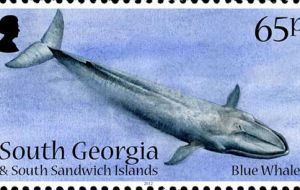MercoPress. South Atlantic News Agency
South Georgia issues new stamps dedicated to blue whales
 The largest mammal: blue whales in the Southern Hemisphere reach lengths of 27-30m
The largest mammal: blue whales in the Southern Hemisphere reach lengths of 27-30m Blue whales are the subject of a new SGSSI stamp issue released on August 31st. The four stamp designs are based on watercolour paintings by artist Kim Chater, according to the latest release from South Georgia News and Events.
The blue whale is the largest mammal, possibly the largest animal, to ever inhabit the earth. Blue whales in the Southern Hemisphere reach lengths of 27-30m, but their Northern Hemisphere counterparts are smaller, on average 23 to 24.5m. Adult females are larger than males, the largest perhaps weighing as much as 150 tons (136,000kgs).
They have astounding body parts – tongues that weigh two tons, a heart as large as a small car, and skinfolds (ventral grooves) that extend from beneath the tips of their lower jaws to their navels. When expanded, these folds increase the interior of the blue whale's mouth to the size of a train's box car. Instead of teeth, blue whales have 300 to 400 fringed baleen plates that hang from their upper jaws and strain their food. They feed on krill, a richly abundant shrimp-like invertebrate that thrives in the waters around South Georgia and Antarctica. During the summer feeding season the blue whale gorges itself, consuming 4 tons or more each day. This means it may eat up to 40 million krill a day!
The blue whale blow (spout) is tall and straight and over 6m high. A small dorsal fin sits three-quarters of the way down the top of the back. They are dark bluish-grey in colour, but often with lighter-coloured blotches or mottling on a darker background (or with darker spots on a lighter background). A blue whale's mottling and blotches, like human fingerprints, are unique to each individual. These blotches allow scientists to identify individual whales. Blue whales also acquire micro organisms called diatoms, which gives the underside of their bodies a yellowish green caste. Because of this yellow colour, the early whalers gave them the name 'sulphur bottoms'.
Blue whales are usually found singly or in pairs. They often lift their flukes clear of the water on their final dive, which may last anywhere from ten to thirty minutes. The blue whale makes deep and rumbling sounds which can be felt as much as heard. These low-frequency sounds travel long distances through the water, allowing them to communicate with each other over hundreds of miles of ocean.
Blue whales reach sexual maturity between the ages of 6 to 10 years, or when males average about 23m and females are about 24m. Calves are born at intervals of 2 to 3 years, and gestation lasts 12 months. Calves are 7- 8.2m long at birth and weigh 2,700kg. Calves nurse for 7 to 8 months and are weaned when they reach 16m in length. At that time they weigh about 20,000kg. During the nursing period, calves consume 379 litres of the fat-rich mother's milk each day, gain 90kg a day, and grow 2.5cm in length a day.
Because of their enormous size and speed, blue whales were safe from early whalers, who could not pursue them in open boats with hand harpoons. But in 1868 a Norwegian, Svend Foyn, revolutionized the whaling industry with the invention of the exploding harpoon gun and by using steam and diesel powered factory ships and catcher boats. He also perfected the technique of inflating dead whales with air so they wouldn't sink after being harpooned. The whaling industry began to focus on blue whales after 1900. A single 27.5m (90ft) blue whale could yield up to 120 barrels of oil, and the blues were killed by the thousands. For management purposes, the blue whale became the measure against which all other whale catches were determined. A catch limit (based on oil yield) was set for blue whales with equivalent limits for other species based on their size compared to the blue whale. This was called the Blue Whale Unit (BWU): one blue whale = two fin whales = 2.5 humpback whales = six sei whales.
The slaughter peaked in 1931 when over 29,000 blue whales were killed in one season. Later they became so scarce that the whalers turned to other species and, belatedly, the International Whaling Commission (IWC) banned all hunting of blue whales in 1966 and gave them worldwide protection. Recovery has been extremely slow, and only in the last few years have there been signs that their numbers may be increasing. Pre-whaling population estimates were over 350,000 blue whales, but up to 99% of them were killed during whaling efforts. Presently, there are an estimated 5 to 10,000 blue whales in the Southern Hemisphere, and only around 3 to 4,000 in the Northern Hemisphere.
The largest blue whale ever recorded was 34.1m. It was caught and cut up at Grytviken in 1912. (Text by Kim Chater)
The new stamps have a face value of 65p, 75p, £1 and £1.20.
South Georgia stamps can be bought from http://www.falklandstamps.com




Top Comments
Disclaimer & comment rules-

-

-

Read all commentsThese British squatters put on stamps what they used to slaughter.
Sep 17th, 2012 - 04:13 am 0http://www.youtube.com/watch?v=jN1TVmy5Qyw
As did the Argentines amongst many others... so your point is what exactly?
Sep 17th, 2012 - 08:16 am 0Meanwhile whales still dying in Argentina.. http://news.discovery.com/animals/whales-dying-in-record-numbers-near-argentina.html
I guess it is all the bullshit coming out of the Casa Rosada....
Wasn't it a temporary whaling station that the Argies base their claim on anyway? Oh, the irony...
Sep 17th, 2012 - 09:09 am 0I still haven't heard any decent explanation as to why Argentina claims South Georgia and the Sandwich islands.
Commenting for this story is now closed.
If you have a Facebook account, become a fan and comment on our Facebook Page!